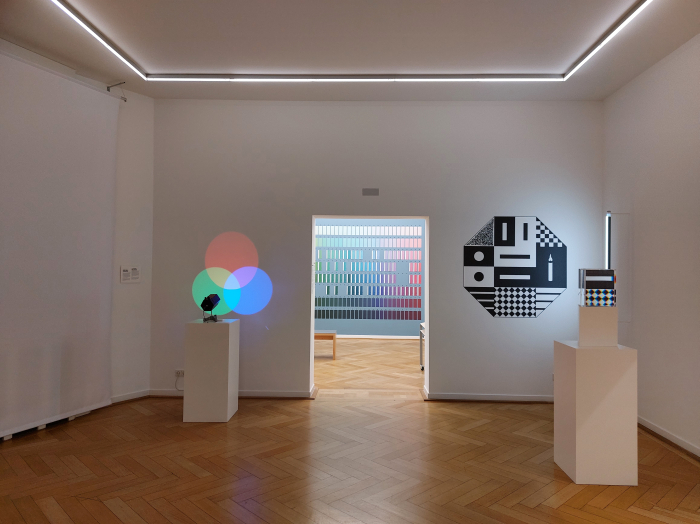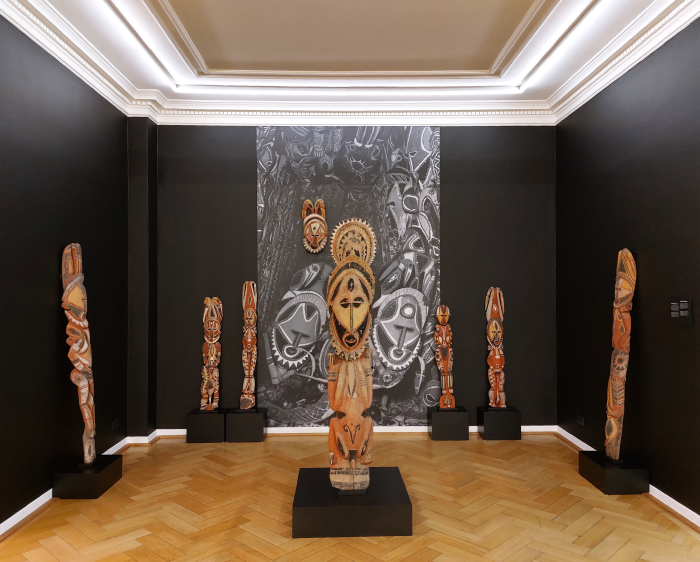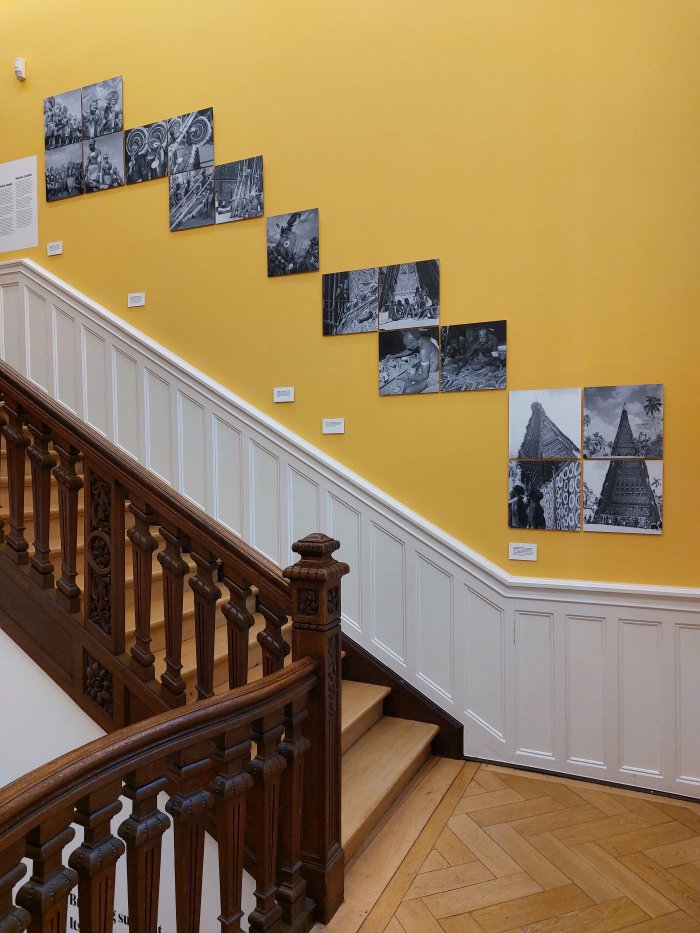Our relationships with colour are invariably shaped and informed by the culture and society in which we were raised. A state of affairs that, equally invariably, leads to us all possessing relatively strictly defined understandings of colour, understandings of the psychology of colours or of the agency of colours or of the use of colours.
With the exhibition Green Sky, Blue Grass. Colour Coding Worlds, the Weltkulturen Museum Frankfurt discuss the cultural relevance and social functions of colour in various and varied contexts and in doing so extend an invitation to expand our relationships with colour, and the world(s) they code.......
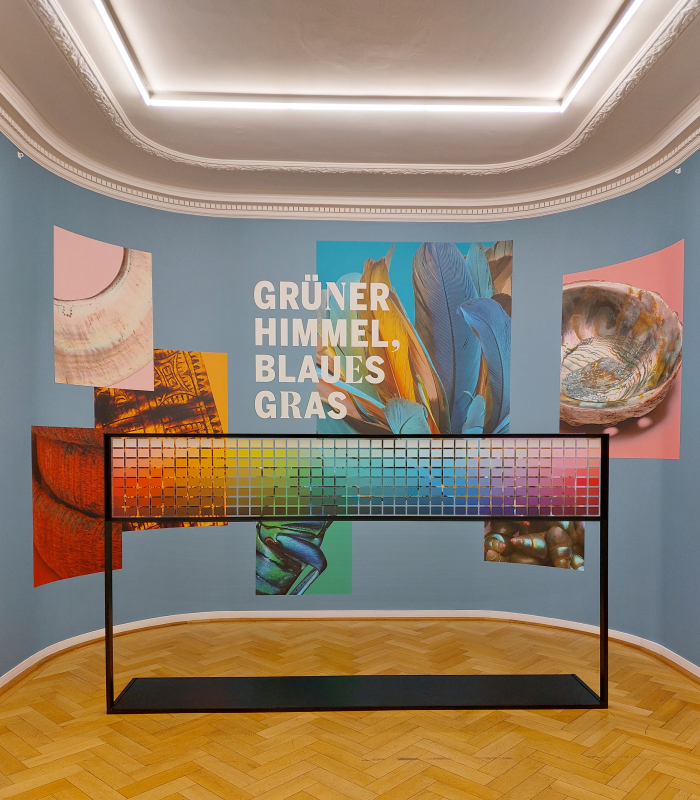
For all that colour has long accompanied and informed global cultures and societies, it wasn't until relatively recently that we began to understand the hows of colour: in the late 17th century Isaac Newton demonstrated that white light was composed of a series of coloured lights which were responsible for the colours of objects and in doing so revolutionised ideas of what colours are and how they arise, before in the 19th century, following on from Antoni van Leeuwenhoek's 18th century work, the functioning of the eye was slowly elucidated, and with it understandings of the roles of cone cells and the Fovea centralis in the reception of colour.
Considerations on the universal, indelible, scientific, rational, basics of colour with which Green Sky, Blue Grass opens, specifically with the question What Makes the World Colourful?, before moving quickly on to its primary discussion of colour in a cultural context, of colour as a cultural good, of colour as more than physics, chemistry and biology; and a primary discussion which is explored via short chapters on topics such as, and amongst others, Ordering Colour, with its reflections on the syntax of colour, the systems and structures by which different cultures and societies organise the nomenclature of colour; Grasping Colour, which discusses both the relationships between colours and materials and objects, and also colour as being able to possess an inherent value; Colourful Cosmologies, with its focus on the ritualistic, semiotic and figurative of colours; or The Colour of Corona which is less to do with virology as with the omnipresent face mask, and which notes that the traditional masks of many cultures often feature colours as expressions of a protective function and/or as an expression of particular characteristics. And that such masks are not worn permanently but only at specific moments for specific reasons.
Which gives you a not unwelcome boost of optimism as you peer at a central African kakungu mask over your characterless, anonymous, industrial, FFP2 mask.
A kakungu mask which forms a component of one of the numerous discussions on colour as employed and understood in and by diverse cultures and communities on which Green Sky, Blue Grass's narrative is carried, including, and amongst many others, discussions on the significance of the coloured feathers of the crowns of the Kayapó of Amazonia, on coloured face painting as a component of mourning amongst the Yaghan of Tierra del Fuego, on the langue of the beaded jewellery of the eastern African Maasai or the relevance of the colours in the paintings of the Avim from Papua New Guinea, the latter featuring a series of works produced in context of a 2018/19 research trip to Avim juxtaposed with works, as one is informed, "collected" in 1961 on behalf of the, then, Municipal Museum of Ethnology, the contemporary Weltkulturen Museum.......
.......hang on... sorry, sorry... stop.......
.......do your hear that... ?
.......listen.......
.......listen.......
.......is that the sound of an alarm bell ringing... ?
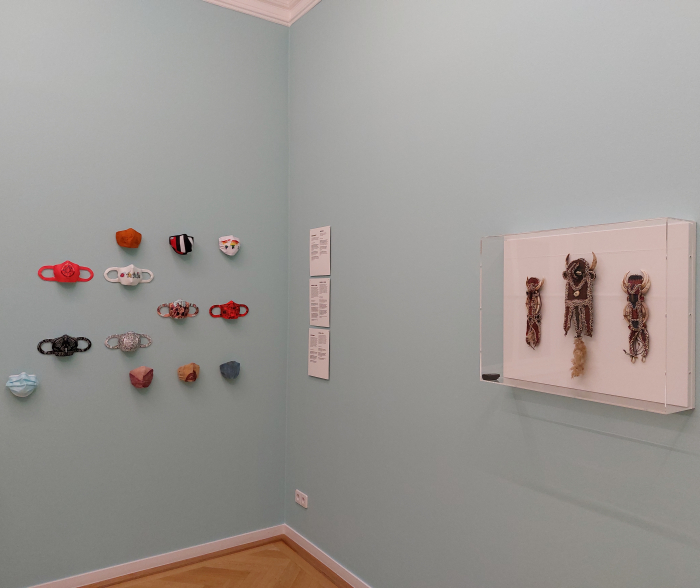
While all European museums whose collections include items arising in cultures and communities physically and structurally far removed from that which the museum calls home, and whose collections were established in, let's say, previous epochs, must be open to questions of the provenance of elements of that collection, ethnography museums are very much a class for themselves: not only is their very raison d'etre human culture in its myriad global manifestations and thereby, by definition, the study of the artefacts and rituals of the myriad global manifestations of human culture, but also, viewed historically, ethnographers, anthropologists, archaeologists and the likes don't always enjoy the, let's say, best of reputations, a great many ethnographers, anthropologists, archaeologists et al from those previous epochs when ethnography museums were established often appearing to contemporary eyes as having been singularly unsympathetic towards those cultures through which they travelled and which they researched.
Here is neither the time nor place for wider discussions on museums' ethnological collections, we leave that very much to James Acaster, nor, unlike Acaster, are we making any specific accusations; is however a reality of the origins and development of museums' ethnological collections that is very present in Green Sky, Blue Grass, not least when one reads a word such as "collected", a word with a great, great, many divergent synonyms. Certainly in an historical context, in context of objects "collected" in previous epochs.
We only have the Weltkulturen Museum's own statements and positions to and on its collection and function, and see no reason to question either the honesty or sincerity of those, nor to question that the provenance of all objects presented in Green Sky, Blue Grass has been thoroughly researched and confirmed; but if we did have one complaint it would be the wish for a little more detail, more transparency, as to how exactly "collected" is to be understood.
For all in context of objects "collected" before 1968, a moment in European (hi)story that appears to have forged new understandings and approaches at the, then, Museum für Völkerkunde der Stadt Frankfurt, a moment that appears to have greatly helped moved it on from those previous epochs and on to the journey towards where it is today.
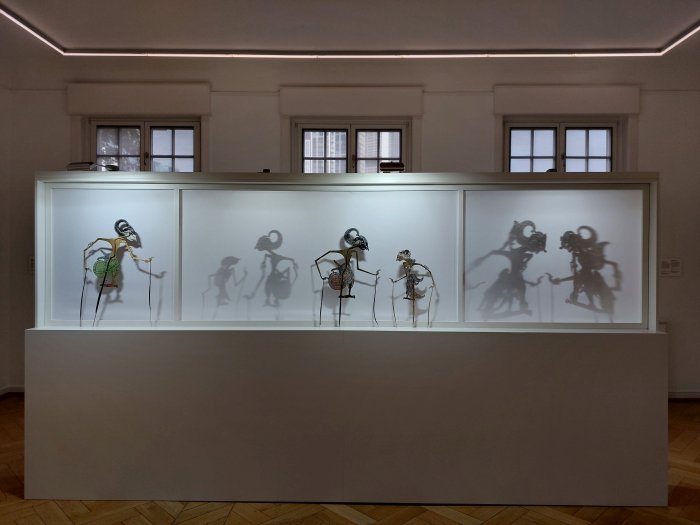
And if we did have two complaint it would be the lack of examples of the psychology, agency, use of colour amongst European cultures and communities, the lack of discussions on the cultural relevance and social function of colour amongst European cultures and communities.
Yes, in the bi-lingual German/English companion booklet which all visitors are given, and which goes into more detail than the bi-lingual German/English wall texts, reference is made, for example, to the use of colour in medicine throughout the centuries in Europe; but as a physical exhibition the focus of Green Sky, Blue Grass is comprehensively non-European cultures, and which thus can tend to imply subscription to an understanding not only of Europe as an homogenous mass with a unified colour coding all European visitors will intrinsically possess, but also to an understanding that the Welt, World, of the museum's name is one external to our European world, is another world, rather than there being one Welt existing as a complex, diverse, permeable, transient whole.
Which we're absolutely certain isn't the impression the Weltkulturen Museum sought to present, and as a presentation Green Sky, Blue Grass certainly isn't one which understands its function as explaining non-European cultures to a European audience, rather is very much an exhibition that employs global examples of the psychology, agency, use of colour as conduits for its considerations on the cultural and social contexts of colour, the various discussions being solidly employed as examples of colour, of the cultural relevance and social functions of colour, not as approaches to definitions and/or delineations of the respective cultures. In many regards the cultures and communities referenced are thoroughly irrelevant, they play no role in the narrative, the focus throughout the narrative is the discourse on colour.
But is a discourse staged outwith continental Europe.
Which is surely unnecessary, undesirable, in context of something as universal and ubiquitous as colour.
Not least because, for us, it is important that we in Europe understand not only that we are not something distinct from the rest of the world, but that we understand our societies are founded on and informed by rituals, traditions, myths, beliefs, inheritance, imbedded structures et al, and better appreciating such involves studying European cultures not only every bit as distracted and distanced as we in Europe explore non-European cultures, but also exploring all global cultures in context of all others, and for all of always considering Europe on a par with, on equal terms with, non-Europe.
And so yes, that ringing you hear walking round Green Sky, Blue Grass is an alarm bell: but alarm bells are positive things as they draw our attention to dangers and confirm that some form of action is required on our part, individually and collectively.
Imagine where our planet would be if as a global society we didn't hear or, heaven forbid, react to alarm bells.....
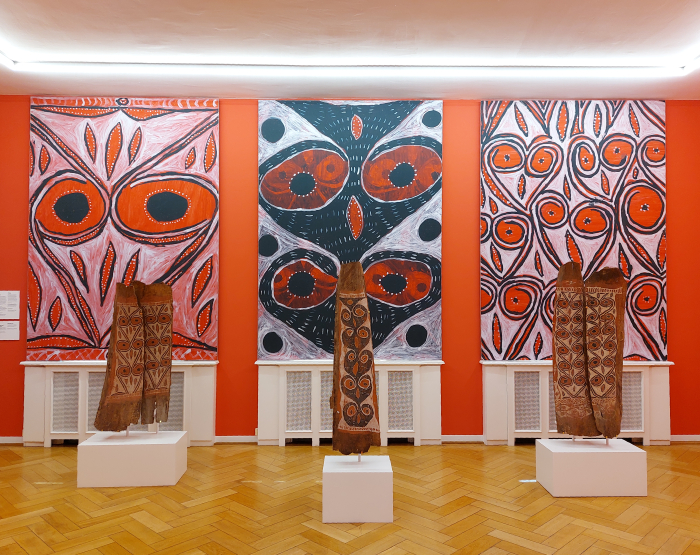
The Green Sky and Blue Grass of the exhibition title are a reference to an ancient Japanese in which terms for blue and green weren't as distinct as in contemporary European tongues, tended more to scales of colours, and where the sky could be green and the grass could be blue. Which grass famously also is in Kentucky. Bill Monroe, Earl Scruggs and Lester Flatt have been very much the soundtrack to the penning of this dispatch.
And much like a flailing banjo or a threshing mandolin, Green Sky, Blue Grass takes the visitor on a sprightly, rhythmic, stimulating, lonesome, reverberating, entertaining, tour through its narrative, a tour which enables new perspectives on colour, new understandings of colour, new appreciations of colour; a tour which very satisfyingly and succinctly helps underscore that that while colours are approached, understood and used in similar contexts and manners across cultures, the specifics of that use vary; and thus a tour which helps elucidate that for all colours are physics, chemistry and biology, colours are languages and subject to the same etymology, same cultural interpretation and definition, same structures and rules of use, same development and evolution as spoken and written language.
And therefore helps highlight that understanding other cultures means understanding their colour languages as much as their spoken and written languages, the importance of focussing less on colours per se, as on the whys and wherefores of colours.
As an exhibition Green Sky, Blue Grass can by necessity of limitations of time and space be but an introduction to that process, an admonishment to more research and reflection; and as an exhibition Green Sky, Blue Grass is a readily accessible and engaging introduction and admonishment .
And an introduction and admonishment to more research and reflections on colour as a social and cultural good from which it is but a short step to better appreciating that valid as your own understandings of our world are, they aren't definitive, and that it may be worth trying to understand our world from the perspective of others, may be worth broadening your own perspective.......
Green Sky, Blue Grass. Colour Coding Worlds is scheduled to run at the Weltkulturen Museum, Schaumainkai 29-37, 60594 Frankfurt am Main until Sunday January 30th.
Full details, including information on the accompanying fringe programme and German/English catalogue can be found at www.weltkulturenmuseum.de
And as ever in these times, if you are planning visiting any exhibition please familiarise yourself in advance with the current ticketing, entry, safety, hygiene, cloakroom, etc rules and systems. And during your visit please stay safe, stay responsible, and above all, stay curious……
